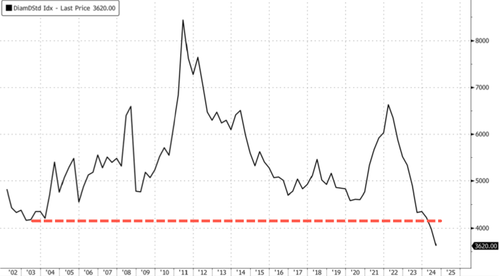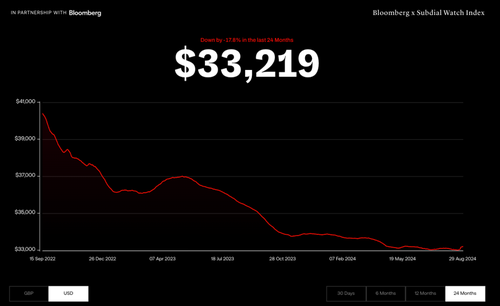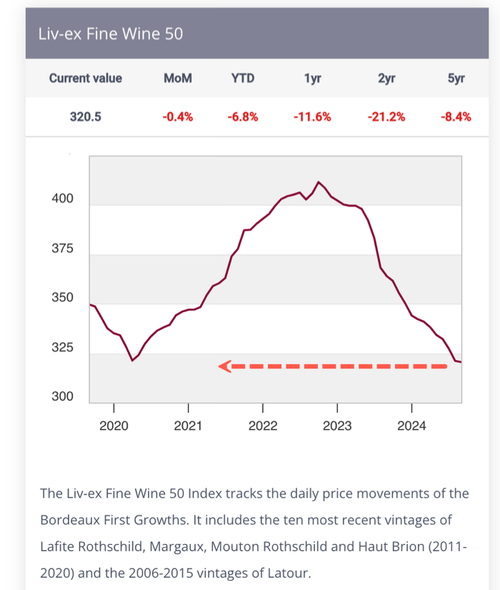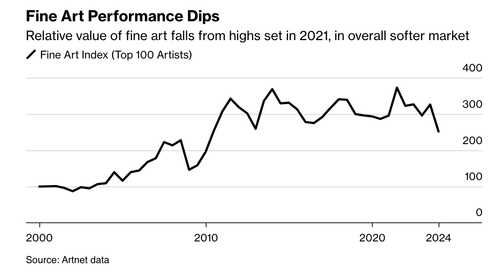
Diamond Prices Crash To Multi-Decade Lows As Art, Wine, & Rolex Markets Sour
The downturn in the diamond market is nothing short of breathtaking. Prices are in free fall as cash-strapped consumers have been shunning luxury goods, grappling with failed Bidenomics that unleashed an inflation storm and resulted in high interest rates. Compounding the issue, the rising demand for lab-grown diamonds has pressured the prices of natural stones.
According to Bloomberg data, citing the Diamond Standard Index, diamond prices have plunged to the lowest on record, with data going back to early 2002. The index has lost 45% of its value since March 2022.

Since diamonds are a consumer-driven market, the fierce bear market in prices signals that the industry is in trouble, as well as signals that low/mid-tier consumers are in trouble. In less than a week, Dollar General and Dollar Tree, with tens of thousands of stores nationwide, have warned that their core customer bases are under pressure. These discount retailers offer a unique glimpse into consumer sentiment that is not manipulated by government statisticians at the BLS.
De Beers, the world’s largest diamond producer by value, recorded its worst year in two decades earlier this summer. Its parent company, Anglo American, recently announced plans to divest and spin off its 85% stake in the diamond subsidiary.
CEO Duncan Wanblad acknowledged the challenges De Beers has faced. In May, he said, „It is sitting at the bottom of a cycle. That cycle is more macroeconomic than fundamental.”
The diamond and luxury goods industry was a major beneficiary of the helicopter money the US government dished out during the Covid era. However, as soon as pandemic savings dried up and the Biden-Harris team ignited an inflation storm through failed Bidenomics, consumers had to quickly dial back spending on diamonds, Rolexes, handbags, and Gucci loafers.
There has also been downward pressure from Gen Z’s distaste for marriage. Some millennials are too broke to afford natural stones and have gravitated to lab-grown diamonds. In recent years, the rapid growth of artificial stones has pressured natural stone prices.
In addition to a collapse in diamond prices, the Bloomberg Subdial Watch Index, which tracks prices for the 50 most-traded watches by value on the secondary market, has sunk nearly 18% in 24 months.

Looking at wine prices on the London International Vintners Exchange, the Live-ex Fine Wine 50 index has plunged below Covid lows, with a 5-year return of around 8.4%.

Let’s not forget that classic automobiles, such as Packard Roadsters and Ford Thunderbirds, or mainly classics before the 1960s, are not selling well at auctions. Baby boomers overpaid for these vehicles, while GenXers and millennials instead seek cars from the 1980s, 1990s, and 2000s, such as 911 Turbos. So much for the old folks trying to dump their 1930s Packards at auction bought a decade or two ago. The market is no longer there.
And the fancy artwork market reverses…

Overall, this note offers a view into consumer health. Low—and mid-tier households are certainly feeling recession-like pressures. Next up, a pullback in spending from higher income households?
Tyler Durden
Thu, 09/05/2024 – 21:05

 1 rok temu
1 rok temu











